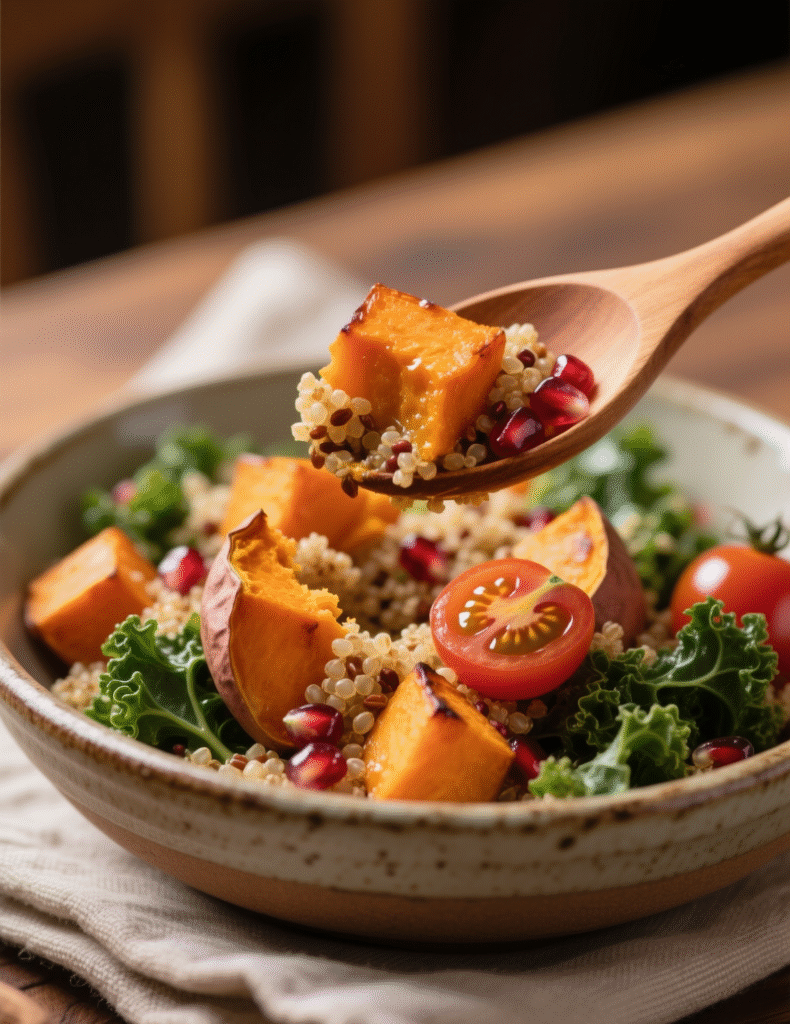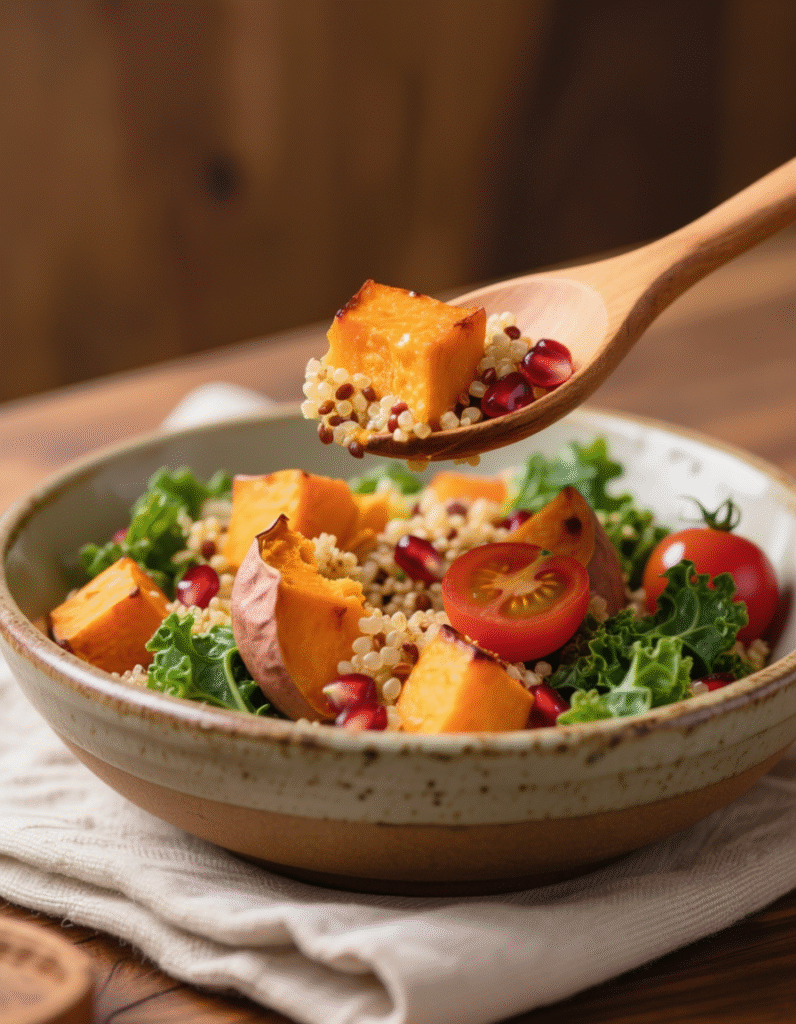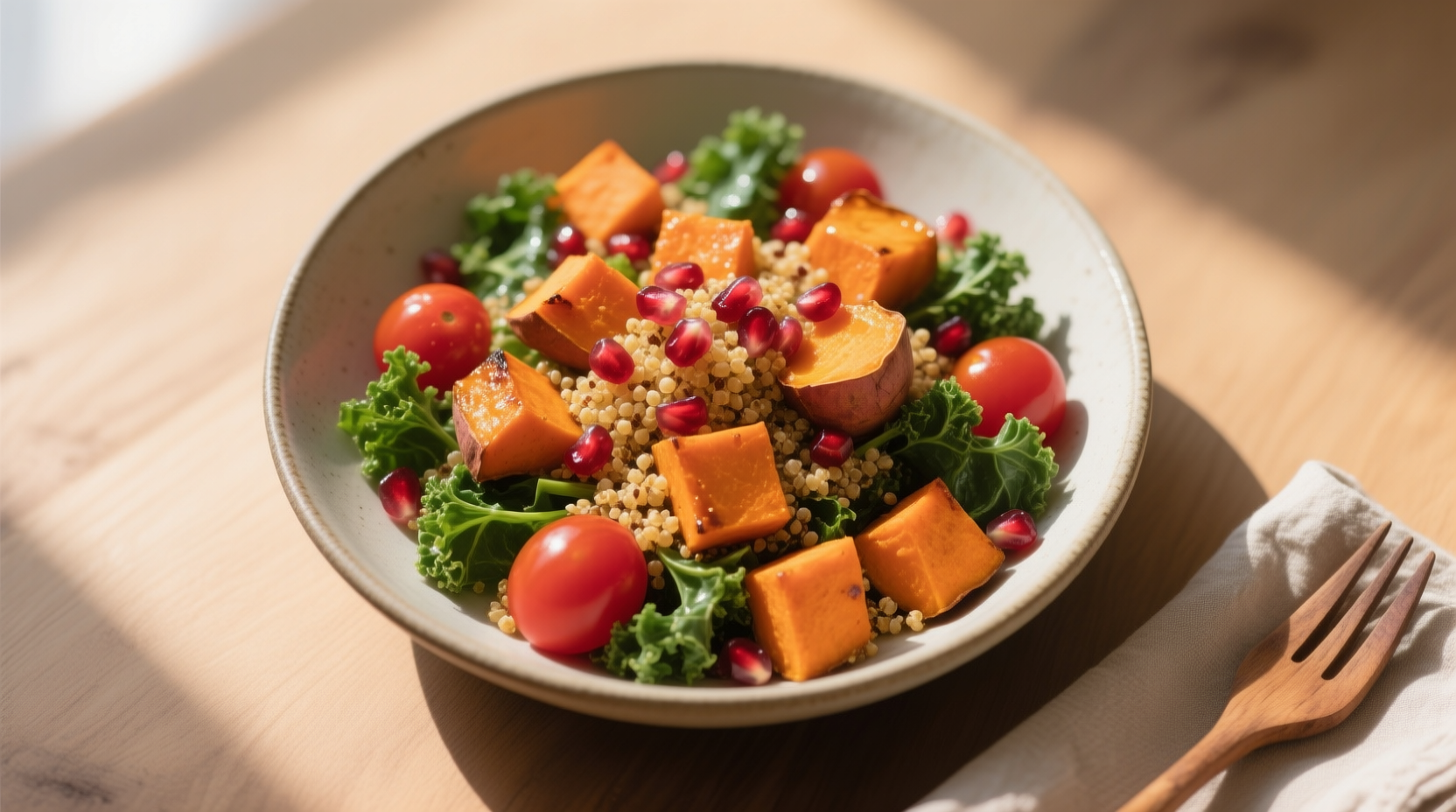There’s something oddly comforting about a bowl that looks like a painter’s palette. A mix of orange roasted sweet potatoes, fluffy quinoa, crunchy greens, and bright toppings hits the senses before the first bite even happens. This isn’t just another trendy salad recipe—this dish stands at the crossroad of science, nutrition, and honest-to-goodness flavor.
Why This Salad Is More Than Just Pretty
At its heart, the roasted sweet potato quinoa salad is built around balance. Not only balance of flavors—sweet, nutty, tangy, earthy—but also balance of macronutrients. Sweet potatoes deliver complex carbs and beta carotene. Quinoa steps in with complete protein, which is rare for plant-based foods. Together, they make a dish that could comfortably sit in a casual home kitchen or on a high-end restaurant menu.
Professionals often underestimate the role of color on a plate. Research from the Journal of Food Quality and Preference shows that color variety increases perceived taste quality by up to 23%. So this salad doesn’t just feed the body, it literally tricks the brain into thinking the meal is more satisfying. That’s not garnish talk—that’s science.
The Core Ingredients That Matter
Sweet Potatoes
Roasting is non-negotiable. Boiling turns them soggy and leeches out flavor. Roasting caramelizes the natural sugars at around 375–400°F, giving them that golden-brown edge chefs live for. Medium-sized cubes, tossed lightly in olive oil, roast evenly without collapsing.
Quinoa
Let’s clear the air: quinoa is a seed, not a grain. Its protein completeness comes from its lysine content, which most cereals lack. For salads, tri-color quinoa works better than white—it holds structure and visual depth. The rinse step? Essential. Unrinsed quinoa has saponins, compounds that leave a bitter, soapy aftertaste.
Greens
This salad doesn’t demand a strict green, but arugula adds pepperiness that balances the sweet potato’s caramel notes. Spinach works for a milder profile, while kale can stand up to heavy dressings. Professional kitchens sometimes blanch kale for 30 seconds to soften fibers, but arugula should stay raw and lively.
Add-Ins
Think contrast. Pumpkin seeds give crunch. Feta or goat cheese adds creamy tang. Diced red bell peppers and pomegranate seeds inject bursts of color and acidity. Each element should have a “job” on the plate, not just sit there.

Dressing: The Invisible Backbone
Salads live and die by their dressing. Here, a lemon-tahini dressing or a cumin-spiced vinaigrette both perform brilliantly. Tahini binds flavor and delivers creaminess without dairy. A touch of maple syrup in the dressing magnifies the sweetness of the potatoes. Balance acid, fat, sweetness, and salt—skew too far in one direction and the whole thing tilts.
In professional kitchens, dressings are never just thrown together. Ratios are tested. Standard vinaigrette uses 3:1 oil to acid, but modern diet-conscious plates often cut that down to 2:1 for brightness. Chefs will whisk until emulsified, but in large-scale prep, a blender ensures consistency across dozens of servings.
Technique That Elevates the Dish
A dish like this looks simple, but execution separates amateur from professional. Roasting on a preheated sheet pan avoids soggy bottoms. Using a wide pan, not a crowded one, lets hot air circulate and crisp edges. With quinoa, fluffing after steaming prevents clumps. Professionals might spread cooked quinoa onto a tray to cool quickly, locking in texture and avoiding gumminess.
Seasoning isn’t an afterthought. Salt the quinoa water like pasta water. Dust sweet potatoes with smoked paprika or cumin before roasting for a deeper dimension. Every layer seasoned means no bland forkfuls.
Nutritional Insights Worth Noting
For a 1 ½ cup serving, you’re looking at about:
- 320 calories
- 8g protein
- 6g fiber
- Over 300% daily Vitamin A (from sweet potatoes)
- Significant magnesium, iron, and potassium
For dietitians, this matters. Quinoa has a low glycemic index compared to rice. Sweet potatoes provide slow-release carbs instead of sugar spikes. Combined, they form a dish that sustains energy—perfect for athletes, office workers, or, frankly, anyone with a busy day.
Professional Applications
In catering, this salad travels well. Quinoa holds structure even after refrigeration, unlike couscous. Sweet potatoes can be roasted a day ahead and gently reheated. Dressings should be packed separately and drizzled right before service. For plated fine dining, microgreens and edible flowers can elevate presentation without compromising flavor integrity.
For meal prep markets, this dish fits the high-demand category of gluten-free, plant-based, protein-rich options. Reports from Statista in 2023 show a 27% growth in global demand for plant-based ready meals. This salad can easily slot into that trend.
Addressing Common Misconceptions
Some people believe quinoa salads are bland. That’s because they skip seasoning at multiple stages. Others think roasted sweet potatoes lose nutrition. In truth, roasting reduces Vitamin C slightly but actually increases antioxidant activity, according to USDA research.
Another myth—salads can’t be filling. This one in particular delivers 8 grams of protein per serving and keeps you satiated longer than a standard leafy green mix. It’s proof that “salad” doesn’t always mean “light.”
Variations That Professionals Experiment With
Chefs don’t stop at the base recipe. They pivot with seasons.
- Fall: Add roasted Brussels sprouts and cranberries.
- Winter: Toss in toasted walnuts and roasted beets.
- Spring: Fresh peas and radishes bring brightness.
- Summer: Grilled corn and cherry tomatoes layer sweetness and acidity.
Middle Eastern spins swap feta for labneh and fold in za’atar. Latin-inspired variations might use black beans, cilantro, and avocado. The versatility ensures it fits menus worldwide.
Plating For Impact
Visual appeal isn’t garnish fluff—it’s strategy. Layer quinoa as a base, scatter sweet potato cubes, tuck greens into the sides, and finish with colorful pops like pomegranate seeds. Drizzle dressing lightly, never drowning. Professional plating studies suggest asymmetry feels more natural and appealing to diners.
In buffet service, wide shallow bowls show off color layers better than deep containers. This maximizes not just aesthetics but also portion perception.

A Note on Sustainability
Quinoa farming once raised concerns in Bolivia and Peru over global demand outpricing local consumers. But recent FAO reports show diversified production spreading across countries like the US, Canada, and parts of Africa. Sweet potatoes, being hardy and low-input crops, also score high on sustainability charts. Together, they align with the culinary industry’s growing focus on eco-conscious menu design.
Expert-Level Tips for Execution
- Roast potatoes at 400°F, flipping halfway, for caramelization on all sides.
- Rinse quinoa for at least 30 seconds under running water—don’t skip.
- Salt quinoa water generously, same as pasta.
- Use a citrus squeezer for the lemon juice in dressing—it extracts oils from the peel too.
- Cool quinoa on a sheet tray if prepping ahead—keeps grains separate.
- Toss salad gently to avoid crushing potatoes into mush.
Why This Recipe Resonates With Today’s Diners
Diners seek meals that balance health with satisfaction. This salad speaks directly to that demand. It’s gluten-free, high in plant protein, packed with antioxidants, and visually arresting. Chefs call dishes like these “gateway healthy meals” because they don’t taste like compromise.
In a time when restaurants fight to attract health-conscious customers, offering vibrant, nutrient-dense bowls makes business sense. For home cooks, it’s a weekday staple that feels elevated enough for guests. For nutrition professionals, it’s a case study in how whole foods naturally deliver what supplements try to replicate.
Conclusion: More Than a Salad
The roasted sweet potato quinoa salad isn’t just a recipe—it’s a canvas. It’s proof that color, nutrition, and technique can merge into a dish that satisfies professionals and casual eaters alike. From sustainability to plating, from flavor science to satiety, it checks every box modern food culture cares about.
Make it once with care, and you’ll see why this salad doesn’t leave the menu rotation easily. It’s healthy without preaching, beautiful without fuss, and versatile without effort. A rare trifecta in cooking.
FAQs
What makes this roasted sweet potato quinoa salad unique?
It combines balanced nutrition, bold flavors, and vibrant colors in one satisfying dish.
Can I prepare the quinoa salad ahead of time?
Yes, just store components separately and mix before serving for freshness.
Do I have to peel the sweet potatoes before roasting?
Not necessary—peels add fiber and crisp texture when roasted.
What dressing works best for this salad?
A lemon-tahini dressing or cumin-spiced vinaigrette pairs beautifully.
Is quinoa really a grain?
No, quinoa is technically a seed but cooks like a grain.
How do I prevent quinoa from tasting bitter?
Rinse it thoroughly to remove saponins before cooking.
Can I make this salad vegan?
Yes, skip cheese or use plant-based alternatives.
Will the salad stay fresh in the fridge?
It keeps well for 3–4 days if stored in an airtight container.
What other vegetables can I use instead of sweet potatoes?
Butternut squash, carrots, or even roasted beets work great.
Is this salad filling enough for a main course?
Yes, the protein-rich quinoa and hearty sweet potatoes make it a complete meal.

Mariana is a passionate home cook who creates delicious, easy-to-follow recipes for busy people. From energizing breakfasts to satisfying dinners and indulgent desserts, her dishes are designed to fuel both your body and hustle.
When she’s not in the kitchen, she’s exploring new flavors and dreaming up her next recipe to share with the Foodie Hustle community.

